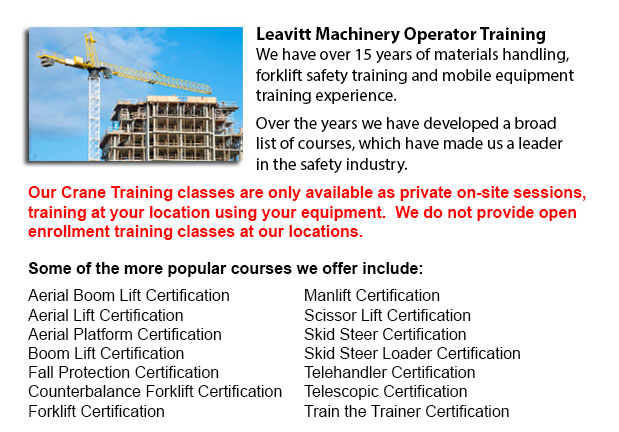
Kelowna Crane Certification - The Crane Certification training program includes content recommended by industry about the safe and efficient operation of cranes. People training would be taught the following: how to identify cranes and their component parts; pre-operational, operational and post-operating requirements; rigging components and inspection/rejection criteria; how to determine overall lift capacity; and requirements specific to the work site where the trainees would be working.
Pre-operational requirements comprise assigning authority for the pre-operational check; doing the sequential pre-operational check based on the specifications certified by a professional engineer or manufacturer's specifications; inspecting the work area for obstacles and hazards; checking the log book for comments; checking cables, hooks, chains safety latches and crane movement; making sure of the right functioning of operational controls; and learning how to make certain that the disconnect switch/isolator of the crane is working properly.
Operational requirements comprise identifying roles and responsibilities, and determining the need for a formal lift plan. People training will learn how to carry out a hazard assessment related to environmental circumstances, physical circumstances and employees. Subject matter includes determining when to seek competent support, the safest route and destination of loads, and centre of gravity and load weight.
Individuals training should be able to identify an over-capacity lift, in addition to be able to choose appropriate rigging machine, choose load restrictions, and to determine the safe spot for the crane to operate from. Individuals training would review both universal and site-specific crane signals for lifts, and techniques for traveling, lifting and loading. Appropriate maintenance practice will be included.
Individuals training would be evaluated on their understanding of the need for emergency response procedures for different conditions like for example a mechanical or electrical failure. They would be asked to describe parking and shut down procedures for security and safety, to follow tagging and lock out techniques, and to explain the reason why near misses are recorded and reported to the right person. Log book records have to be maintained.
People training would develop knowledge of rigging, particularly, establishing who has responsibility and authority for rigging, identifying various types of rigging, knowing storage procedures and load capacity ratings.
The requirements following operation of the crane will be taught as well, learning to enter the defects and deficiencies; and to log the history of maintenance and service records, in accordance to the state, provincial and federal codes requirements.
In addition, we include site-specific needs to be able to meet the employers requirements into our crane certification training program.
-
Kelowna Forklift Training Program
Kelowna Forklift Training Program - The lift truck is a common powered industrial vehicle which is in wide use these days. They are sometimes called hi los, lift trucks or jitneys. A departments store would use the forklift to unload and load merchan... More -
Kelowna Crane License
Kelowna Crane License - Crane operators ought to be "credentialed", that means they ought to have a crane operator certification or license. Credentialing is considered a mandatory governmental requirement in order to practice as an operator of a cra... More -
Kelowna Boom Lift Safety Training
Kelowna Boom Lift Safey Training - Boom lifts fall under the type of elevated work platform or aerial lifting device. Most usually used in warehousing, construction and industry; the boom lift is so versatile that it could be utilized in almost whate... More -
Kelowna Loader Training
Kelowna Loader Training - Loader Training - Any individual who would like to operate a forklift should take a Loader Training course in order to become a certified forklift truck operator. There are a variety of ways to obtain forklift training. Cour... More -
Kelowna Aerial Lift Safety Training
Kelowna Aerial Lift Safety Training - Each and every year, there are roughly 26 construction deaths attributed to the use of aerial lifts. Most of the craftsmen killed are electrical workers, laborers, painters, ironworkers or carpenters. The majorit... More -
Kelowna Crane Ticket
Kelowna Crane Ticket - Modern cranes can either be simple or complex, based upon the nature of the application they can carry out. For example, mobile cranes are somewhat simple units. A telescopic boom and even a steel truss mounts its movable platf... More -
Kelowna Boom Lift Operator Training
Kelowna Boom Lift Operator Training - The cherry picker work platform is a type of work platform, that will typically have a bucket or platform at the end of a hydraulic lifting system. The machine is likewise referred to as a man lift, boom lift, hy... More -
Kelowna Heavy Equipment Ticket
Kelowna Heavy Equipment Ticket - Depending on the nature of the job at hand, the kind of construction equipment that a heavy equipment operator makes use of differs. Every kind of machine is made to perform particular tasks in the most effective mann... More

Leavitt Operator Training
TOLL FREE: 1-888-254-6157
101-864 McCurdy Place
Kelowna, British Columbia
forkliftcertificationkelowna.com
Email Us
About Us


